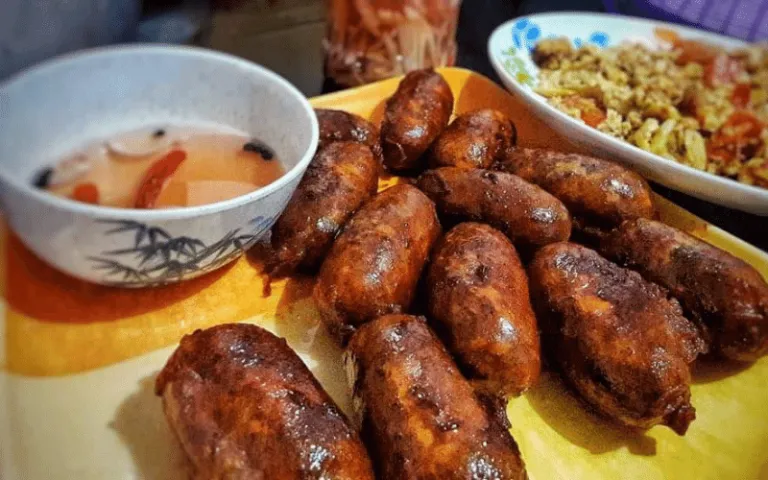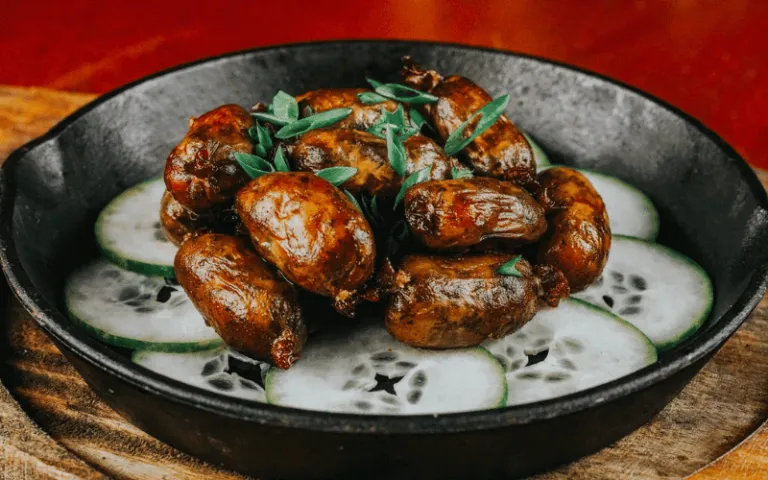Our favourite places to stay on this sleepy Cebu island.
10 Best Longganisa in the Philippines & Where to Get Them

I love longganisa. But admittedly, I used to discriminate against some regional flavours. With all the kinds of , I had to stick to one favourite so as to not get overwhelmed. And as a slight Ilokana, I’ve always leaned towards Vigan longganisa by default.
It was only when my friend sent me packs of Nueva Ecija longganisa last month that I had to rethink my bias. Full and pungent when cooked, this garlic longganisa posed as a strong contender against my all-time favourite. Thanks to that delectable experience, I now welcome the different kinds of with an open mind.
From here on out, I am scrapping all prejudice and starting my search for the best . For now, let me convene all the kinds we know into this one juicy list. You’re welcome.
10 kinds of
1. Vigan longganisa

Of course, I start this list with the longganisa closest to my heart. Nothing quite compares to the garlicky aroma of Vigan longganisa — and I can say this with confidence. After all, it’s loads of garlic that sets this type apart from all other kinds of .
While Vigan is not the only city that produces longganisa de recado, it sure has its edge because of its location: Neighbouring by Vigan is the quaint town of Sinait, which is also known as the Garlic Center of the North. No wonder Ilocanos go all out on the herb!
Plump and smoky, Vigan longganisa is best paired with silog and sukang Iloko. It’s also a key ingredient for Vigan empanada, another Ilocano favourite — but that’s a story for another day.
Also read: 15 Must-Try Restaurants in Vigan City, According to True-Blue Ilocanos
2. Lucban longganisa

European influences are exceptionally evident in Lucban longganisa. Not only does it incorporate garlic and vinegar, it also makes use of Mediterranean spices like oregano and paprika.
Leaner than most longganisa types, Lucban longganisa is distinguishably salty and sour at the same time. Quezon Province celebrates this delicacy through the Pahiyas Festival, where locals use longganisa as an ornament.
The next time you find yourself in Quezon, make sure to enjoy your Lucban longganisa with silog and the equally famous pancit habhab!
3. Pampanga longganisa

A Filipino food guide can’t exist without the mention of the Culinary Capital of the Philippines. Pampanga boasts of having the best of both worlds: its longganisa jamonado and longganisa de recado are both to die for! The latter is more known as the Guagua longganisa, hailing from the eponymous Kapampangan town. But it’s the former that has risen to fame nationwide.
Pampanga’s Best has become a household name across the country — mostly for its iconic tocino, but also for its longganisa hamonado. This variant makes a Pinoy favourite because of its classic sweet and salty taste — a fusion that inescapably favours the Filipino palate.
Distinctively long, skinless, and reddish, this longganisa variant tastes divine paired with salted egg and papaya atsara. Mangan tamu!
4. Calumpit longganisa

Long and stout, the Calumpit longganisa is as filling as it looks. Hailing from Bulacan, this dish is also known as longganisang bawang; needless to say, it’s packed with our much-loved garlic! Its aroma intensely competes with that of the Vigan longganisa, only the former is paler in colour and infuses a sumptuous amount of pepper to balance its taste.
In addition to its garlic and pepper flavours, Calumpit longganisa also lavishes the taste buds with bay leaves, brown sugar, paprika, and soy sauce. Most Bulacanos make use of leaner meat for their longganisa, resulting in a pork delicacy that isn’t too fatty.
5. Tuguegarao longganisa

Yet another longganisa variant that hails from the North, the Ybanag longganisa is a proud product of Tuguegarao City in Cagayan Valley. A striking ingredient incorporated into this longganisa is the atsuete (annatto), which noticeably produces its yellow hue. The classic kind offers carabao meat as fillings; but, other mainstream sellers now use pork meat, too.
As garlic also flourishes in the province, expect the Tuguegarao longganisa has a strong, garlicky taste as well. In fact, this type of longganisa is so rich in garlic that some natives use it to ward off aswangs!
Juicy and crunchy, Tugueguarao longganisa is good on its own, but much better with sukang pinakurat. This variant also thrives as an ingredient in different food recipes, like pochero and sotanghon.
6. Cabanatuan longganisa

I was today years old when I learned that Cabanatuan is the Longganisa Capital of the Philippines. But after my delightful experience with this variant, I’m not too surprised!
Apparently, Cabanatuan sells a wide variety of longganisa flavours: jamonado, de recado, spicy, and batutay. Most famous among them all is the batutay, which uniquely defines itself through its use of beef instead of pork. Its tang finds the perfect balance between sweet and salty, winning the hearts of most consumers.
Cabanatuan City well reveres its longganisa, so much so that it holds an annual Longganisa Festival! During the fiesta, Novo Ecijanos participate in cooking contests, preparing different recipes that incorporate the iconic ingredient.
If you get your hands on Cabanatuan longganisa, I suggest that you try experimenting with it as well! Locals enjoy it fried, but you can also use it for spaghetti or binagoongan. With its sumptuous flavour, every dish would turn out impressive!
Also read: 15 Festivals in the Philippines to Anticipate Every Month
7. Alaminos longganisa

Unlike the other kinds of that are linked together by string, Alaminos longganisa is easily identifiable because the pieces are held together by buli grass strings (usually mistaken for toothpicks). Usually, locals produce each link with six pieces of longganisa.
A long-standing treasure of Alaminos City, this longganisa variant is mainly composed of ground lean pork and pork fat. Makers also use atsuete for its natural colouring.
Pangasinenses love having Alaminos longganisa for breakfast, as its savoury flavour makes an appetising pick-me-up. Compared to most kinds of , it has a subtler taste — but that’s exactly what makes it special! Pangasinan celebrates the naturally palatable taste of Alaminos longganisa through their annual Longganisa Festival.
8. Bacolod chorizo

Chicken inasal isn’t the only gem in Bacolod. Once you find yourself in the City of Smiles, make sure to try out their longganisa, too!
Bacolod is the only place in the Philippines where you’ll find smoked chorizos. The locals call it chorizo negrense, a delicacy that has existed in the city since time immemorial. Adding a tangy taste, calamansi is usually incorporated into this dish.
Ereñeta-Manaloto Chorizo de Bacolod, arguably the most famous style of Bacolod longganisa, has been producing their heirloom recipe since the 1930s. “It is our aim to put Bacolod in the longganisa map,” Ereñeta-Manaloto tells TripZilla Philippines. “If Cebu has the chorizo de Cebu, we thought, why not have chorizo de Bacolod? And so, we branded it that way. Only in 2017, we had the opportunity to join the Negros Trade Fair in Manila. We finally got the chorizos recognised out of Bacolod.”
Bacolod chorizo comes in either jamonado or recado: the former providing a caramelised goodness of smoked pork; the latter boasting a sinfully irresistible amount of fat. You can also choose to have it skinless (chorizo pudpud) or plump and oozing.
Also read: Occidental-ly in Love: 10 Things to Do in & Around Bacolod, the City of Smiles
9. Longganisa de Guinobatan

In the province of Albay, another town celebrates annual Longganisa Festivals. This is Guinobatan, a first-class municipality responsible for the famous longganisa de Guinobatan.
Remarkably, longganisa de Guinobatan is filled with chopped pork meat, as opposed to the more common ground meat. Guinobatanos traditionally make this dish with bare hands — a tender feature to this Albayano speciality. As longganisa de Guinobatan is a garlic longganisa, it pairs best with vinegar and sinangag!
10. Chorizo de Cebu

What sets Cebu longganisa apart is its fusion of de recado and jamonado flavours. Reflective of the diversity of the country’s oldest city, Cebu longganisa has the perfect balance of sweet, spicy, and garlicky! When wrapped in hog casing, the longganisa is usually round in shape — also called chorizo de Cebu. You can also find this variant in skinless form.
Cebuanos typically serve chorizo de Cebu with puso — traditional rice enclosed in lukay (coconut fronds). Plus points if you have it with silog and hot chocolate!
Also read: 20 Restaurants in Cebu City That Will Keep You Coming Back for More
Interestingly, every kind of has a long history and rich culture attached to it. Ultimately, one thing binds them all: They all seem too mouth-watering to resist! What are your longganisa favourites? Don’t forget to let us know in the comments!
Featured image credit: feryswheel | Facebook; Paul David | Flickr
Published at
About Author
Danielle Uy
Subscribe our Newsletter
Get our weekly tips and travel news!
Recommended Articles
10 Bantayan Island Resorts, Hotels, and Rentals for Your Tropical Escape 10 Best Banawe Restaurants for a Mouthwatering Food Trip in QC The promise of new flavours beckons from Banawe.
10 Best Mountain Cafes in the Philippines for Your Peak Coffee Experience Coffee date on the mountains, anyone?
10 Family Outing Ideas in Metro Manila Under ₱500 Looking for a weekend bonding with the family under ₱500? Head to these places, pronto!
10 Fun Things to Do in Manila Alone Live your best life in Manila, even when you’re riding solo.
Latest Articles
Spain’s New Check-In Requirements: What Travelers Should Prepare For Euro summer just got... tighter?
Where Not to Travel in 2025: Fodor’s Perennial No List Destinations Do you agree with this list?
Your Guide to the New Korean Visa Application Process for 2025 Major changes ahead for South Korean travel.
Nine Million Tulips: A 'Wicked' Travel Experience Awaits Oz comes to life!
Top 10 Post-Breakup Destinations for Healing and Self-Rediscovery Ready for a solo travel?

